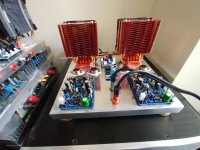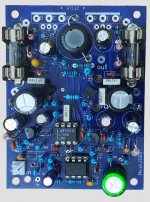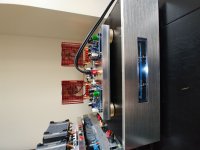Have anyone managed to create a fan control for cooling just using a NTC and a computer fan?
A Noctua fan at slow rpm would be virtually silent so I am thinking it may be possible to do a simple solution like this but I don't know if the NTC range would be enough.
A Noctua fan at slow rpm would be virtually silent so I am thinking it may be possible to do a simple solution like this but I don't know if the NTC range would be enough.
If you have a 12 v power supply it is simple. Get a nfet, a salvage one from a switcher supply is fine. Good nfet the gate is not shorted to drain or source. Some have a diode drop to one. Nfet source goes to - supply. Connect the gate of nfet to source (-supply) with a resistor. The size of the resistor depends on the resistance of the NTCR. NTCR goes between gate & plus supply. Fan goes to + supply and nfet drain.
Pulldown resistor holds nfet off & fan off until NTCR resistance gets low enough to pull gate near 5 v. Then fan turns on. You can experiment with metal plate, NTCR, & thermal probe of DVM to pick the pull down resistor for what temperature switch on. Hint NTCR salvage from PCAT power supplies is about 10k ohms.
Pulldown resistor holds nfet off & fan off until NTCR resistance gets low enough to pull gate near 5 v. Then fan turns on. You can experiment with metal plate, NTCR, & thermal probe of DVM to pick the pull down resistor for what temperature switch on. Hint NTCR salvage from PCAT power supplies is about 10k ohms.
I was using this board:
NEW DC 12V PWM PC CPU Fan Temperature Control Speed Controller Board 5*4.3cm | eBay
in several of my amps. Works perfectly with any CPU heatsink/fan (12V).
This little board in front of the fan controller, is a buck converter, that lower rails voltage from 50V to 12V.
The fans are Noctua fans. For normal listening, they are dead silent..
The amp is Elvee's Current Dump Amp
NEW DC 12V PWM PC CPU Fan Temperature Control Speed Controller Board 5*4.3cm | eBay
in several of my amps. Works perfectly with any CPU heatsink/fan (12V).
This little board in front of the fan controller, is a buck converter, that lower rails voltage from 50V to 12V.
The fans are Noctua fans. For normal listening, they are dead silent..
The amp is Elvee's Current Dump Amp
Attachments
Last edited:
What is that? Breadboard on aluminum? I like the aesthetic. And look at all the rev's on the left!
Some fans have a PWM input for speed control. One time I was asked to investigate if the frequency of the PWM mattered. Some of the fans didnt even care if it was PWM at all; they were happy with a DC level on the PWM input. That would simplify things.
What is that? Breadboard on aluminum? I like the aesthetic. And look at all the rev's on the left!
Definitely not a breadboard 🙂 Real PCBs.
Yes, on a slab of aluminum. Big box underneath, contains a PSU, VU meters, speaker protection.
Attachments
Last edited:
Try putting an AC fan with control from a thermostat using the contacts that turn on when a temperature is reached.
AC fans are more reliable, and usually they are bigger, so run more quiet.
DC fans are also squirrel cage motors with a DC-AC converter inside, for the most part.
And you can use a series resistor or capacitor to slow down an AC fan when less cooling is needed, at higher temperature the thermostat bypasses the drop device, more cooling is delivered with increased flow.
Choose the largest fan you can fit, those used in frost free refrigerators are quiet with decent air flow figures.
Generally for the same flow a larger fan will turn slower, so less noise, for the same number of blades.
AC fans are more reliable, and usually they are bigger, so run more quiet.
DC fans are also squirrel cage motors with a DC-AC converter inside, for the most part.
And you can use a series resistor or capacitor to slow down an AC fan when less cooling is needed, at higher temperature the thermostat bypasses the drop device, more cooling is delivered with increased flow.
Choose the largest fan you can fit, those used in frost free refrigerators are quiet with decent air flow figures.
Generally for the same flow a larger fan will turn slower, so less noise, for the same number of blades.
Last edited:
I'm planning a JLH 1969 amp with active (but silent) cooling and plan to use a cheap PWM controller to run a Noctua (or 2).
ZFC39 PWM Fan controller - YouTube
EDIT: Oops, looks like MineK beat me to it. My amp is going to be very similar to that in concept/design! Here I was thinking how unique my amp would be. 🙂
ZFC39 PWM Fan controller - YouTube
EDIT: Oops, looks like MineK beat me to it. My amp is going to be very similar to that in concept/design! Here I was thinking how unique my amp would be. 🙂
Last edited:
I just use a center-off toggle switch with the high position full speed, and the low position with a series resistor for the lowest practical speed. That way I choose the speed depending upon the duty cycle I am imposing on the amplifier. Never failed me yet...
I just use a center-off toggle switch with the high position full speed, and the low position with a series resistor for the lowest practical speed. That way I choose the speed depending upon the duty cycle I am imposing on the amplifier. Never failed me yet...
What resistor values and fan mfg/type are you using?
That would help me to try and find a NTC that might work.
Funny how one needs to ask the question before figuring out how simple it can be.
I had a left over 140mm fan rated 12v/0.3ah and set it up to test different resistor values. With 160 ohm it will start and low enough rpm for it to be quite from a 30 cm distance, with 220 ohm it would not start, 200 ohm it would whine a bit but eventually start.
TDK has a NTC rated 150 ohm, 450mW and will go to 33 ish ohms at 65 degrees so should make for a possible solution.
I had a left over 140mm fan rated 12v/0.3ah and set it up to test different resistor values. With 160 ohm it will start and low enough rpm for it to be quite from a 30 cm distance, with 220 ohm it would not start, 200 ohm it would whine a bit but eventually start.
TDK has a NTC rated 150 ohm, 450mW and will go to 33 ish ohms at 65 degrees so should make for a possible solution.
There you go! Every fan is different and the resistor required for slow speed, reasonable airflow, AND reliable starting will be different for each fan. I use something called a decade resistor box, which is essentially a resistance substitution box with a bunch of slide switches and 2 Watt resistors, to determine what the right resistance is for that specific fan. Bear in mind that once you're past reliable starting that too low a speed may also not do very much from an airflow standpoint because of the fan blade pitch and housing constraints. I little strip of paper held by a tweezer will give you a good idea.
BTW, I also use the same decade resistor box to adjust the brightness of panel LEDS by determining the correct current limiting resistor to use. This avoids having a blindingly bright LED beaming at your eyes. Some of today's LEDs are so bright that the old 1K ohm rule of thumb no longer applies!
BTW, I also use the same decade resistor box to adjust the brightness of panel LEDS by determining the correct current limiting resistor to use. This avoids having a blindingly bright LED beaming at your eyes. Some of today's LEDs are so bright that the old 1K ohm rule of thumb no longer applies!
- Home
- Amplifiers
- Solid State
- Simple cooling fan control?


